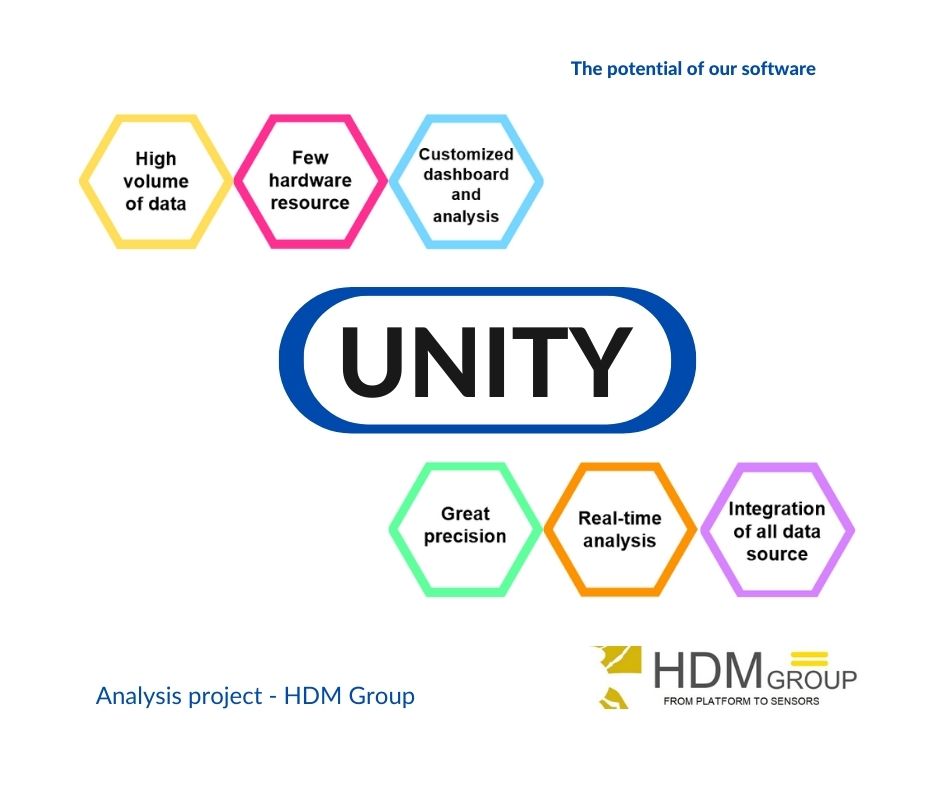
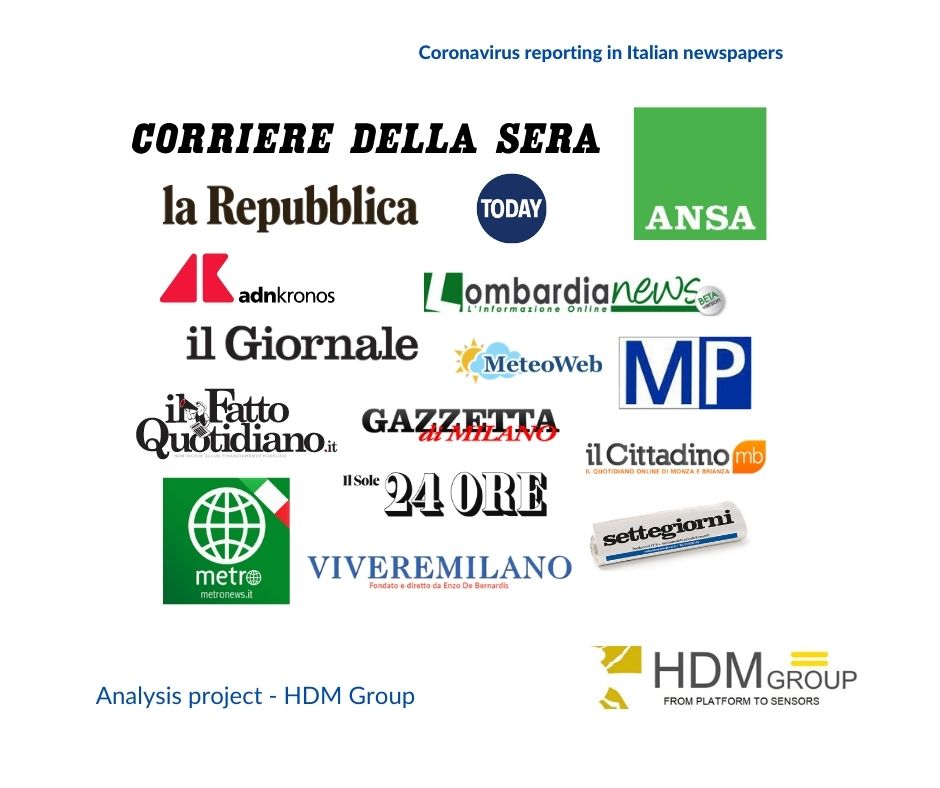
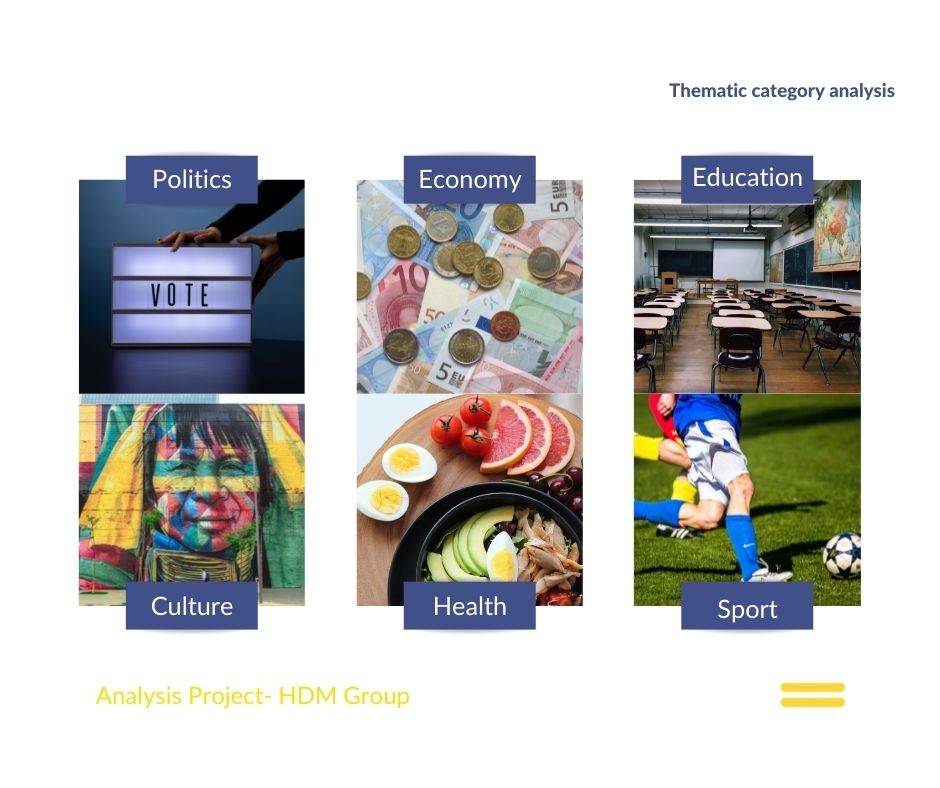
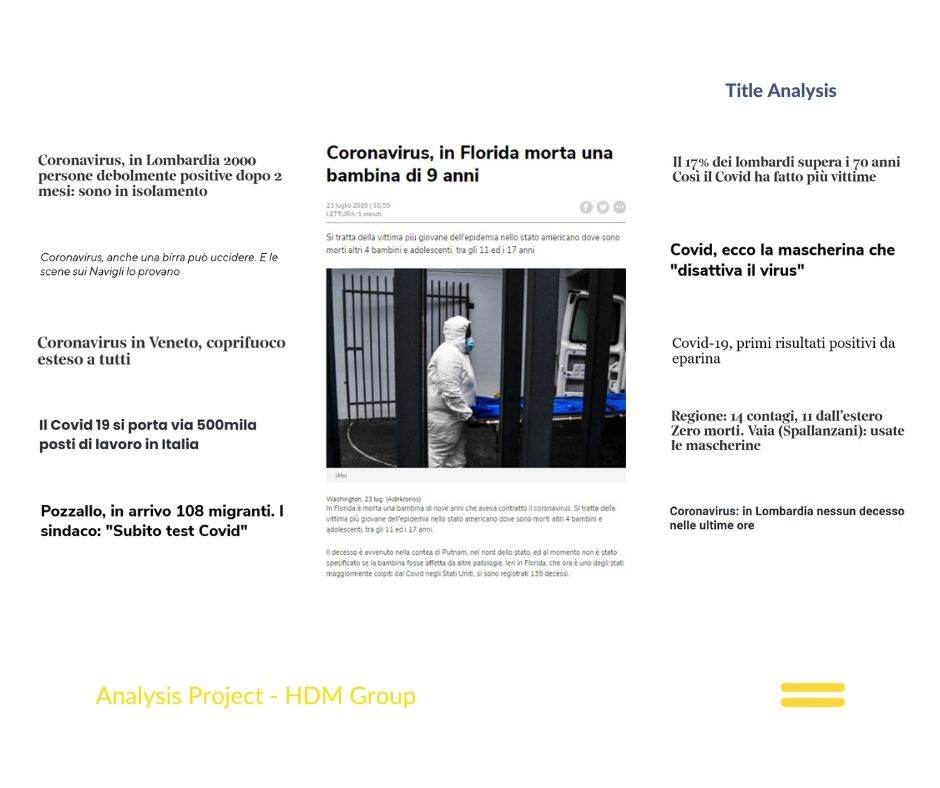
We begin today with our weekly appointment that involves our analysis project that has Coronavirus as its central theme.
Through the innovative system Unity, we carried out a detailed communicative analysis on an extended sample of articles published by italian newspapers on their respective digital platforms.
Unity software is a solution that deals with data processing and analysis and connects various types of analytical tools with each other. It is a system designed specifically for carrying out statistical studies. For more information, click here.
Our research is focused on the Coronavirus topic, and it has the purpose of making an in-depth analysis of the communication methods used by various italian digital newspapers to inform the public on the specific situation.

The reference period of our articles sample matches with the declining phase of the Covid-19 epidemic that took place during summer 2020 that allowed the mitigation of preventive measures adopted to tackle the epidemy and the resuming of activities and events that were suspended because of the virus. However, there is also a small number of articles that are part of the sample which were published between February and May, during the initial months of the epidemic outbreak in Italy.
Starting from a sample of 9701 articles, found thanks to our innovative system Unity, we executed a careful selection to trace relevant articles and examine them in detail.
More specifically, we examined the newspapers which published the articles, the dominant topic categories of the articles that cover Coronavirus news and their lenght. In addition, we investigated to find information about the titles, their tone, and the most used keywords.
Stay tuned to discover more about our project! Next week we’ll cover the distribution of articles for each newspaper and their lenght.
Today we continue with the second part of our communicative analysis which involves the sample of articles reporting Coronavirus news that we collected, and the respectives newspapers that published them.
For more information on our analysis project executed through the innovative potential of our software Unity, click here.
Through the use of our data processing software Unity we managed to collect 1129 newspapers articles that deal with the Coronavirus topic, starting from the initial sample of 9701 articles.
The set of 1129 articles includes 262 correlated articles which relate to topics close to that of Coronavirus and events that are consequences of the epidemic.

Among the 67 italian newspapers that published the articles that are part of our sample of 1129 articles, 45 of them are local newspapers and 17 are national newspapers.
Those are followed by:
They represent the remaining 144 articles (13% of the total).
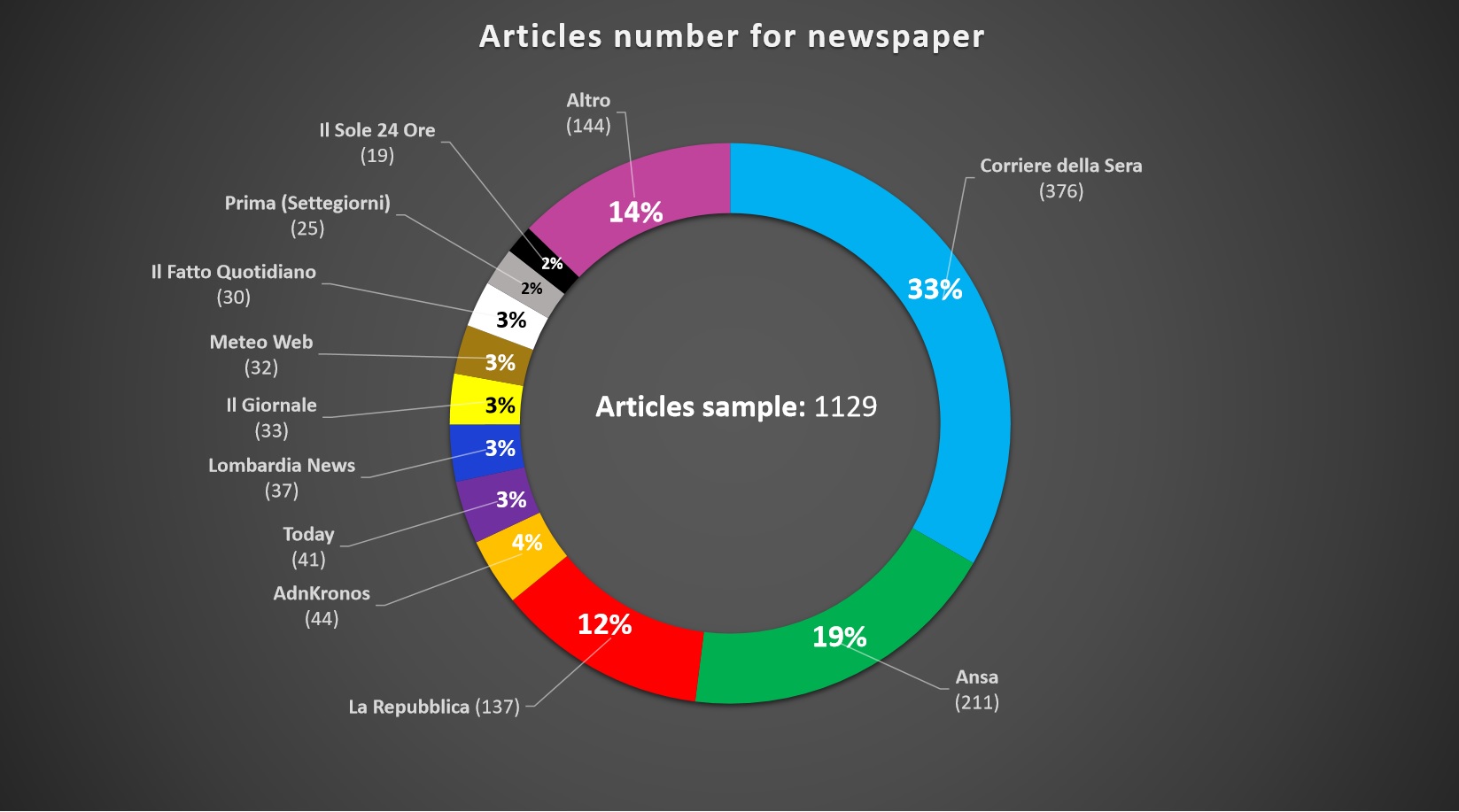
We also analyzed the specific lenght of the articles whose texts are still detectable (1107 of the 1129 articles). We have found that 50% of them are short articles, 30% of them are medium-lenght articles and 20% of them is made up of in-depth articles.

In addition, there are articles published by 3 specialized magazines and 2 blogs. Excluding the articles published by those two (which represent 7% of the total), between the sample of 1129 articles 598 were published by local newspapers (53%) and 457 were published by national newspapers (40%). It’s remarkable the presence of the press agencies Ansa and Adnkronos.
Between the 67 newspapers detected, the ones which have the highest number of articles covering the Covid-19 topic are: the “Corriere della Sera” with 376 articles (33% of the total), 329 of which belong to local editions of the newspaper and internal blogs; Ansa with 211 articles (19%) and “La Repubblica”with 137 articles, 52 of which were published by local editions and magazines.
In our next appointment we will look into the topic categories of our articles sample. Continue to follow us in order to find out more about our analysis project.
This is the third part of our analysis of the communication concerning Coronavirus that involves an investigation on the specific topic categories of the article that belong to the sample we collected.
If you are looking for more information on our analysis project executed thanks to the potential of our innovative software Unity, click here!
The articles which cover the Coronavirus topic are mainly chronicle news articles. As a matter of fact, 692 of them cover news stories (61% of the total). Then we have the following categories:
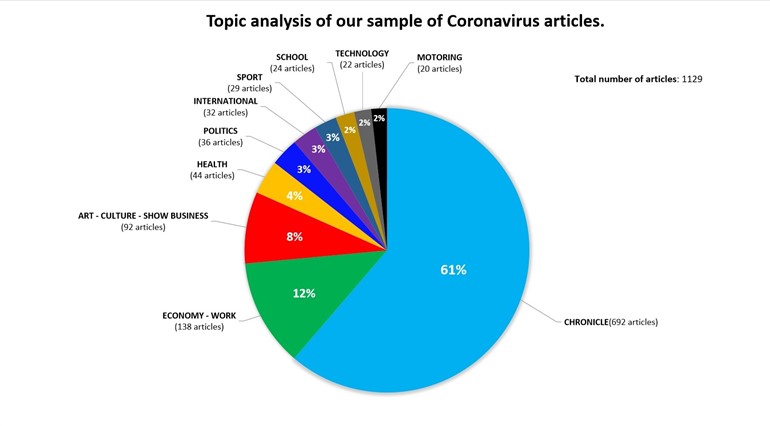
The articles which belong to the “Economy and work” category address topics like funding and donations planned to deal with the crysis induced by the Covid emergence, like the renowned Recovery Fund.
The remaining part of articles deal with the subjects of smartworking and the economic impact of the epidemic.
With regard to the category “Art, culture, show business”, the majority of articles cover events and shows that were postponed, suspended or held in different modalities compared to the normal because of the virus, and the reopening of museums and libraries.

A substantial part of the initial sample of articles deals with “bulletins” (in italian “bollettini”), news articles which focus on numbers involving the epidemic like the number of infected people, deaths, swabs. More specifically 212 articles of our sample (19%) fall into this category.
These articles focus especially on the number of positive cases and deaths. This emerges from an analysis of the titles of the articles, which in most cases recall more than one type of data. The most used combination for titles reports the new positive cases and deaths numbers. Specifically, between the 163 titles of articles that cover bulletins, 132 of them (81%) refer in a non-exclusive way to the number of infections and 70 of them (43%) contain the keywords “deaths”, “fatalities” and “victims”. Only 9 titles report the number of swabs, and only 4 titles refer to recovery cases.
Our next article will cover an analysis that we executed on the titles of our articles sample. Stay tuned to find out more about our project!
This is our last appointment of our communication analysis regarding Coronavirus coverage by italian digital newspapers. The last part of our analysis is dedicated to the titles of the articles belonging to the sample we collected.
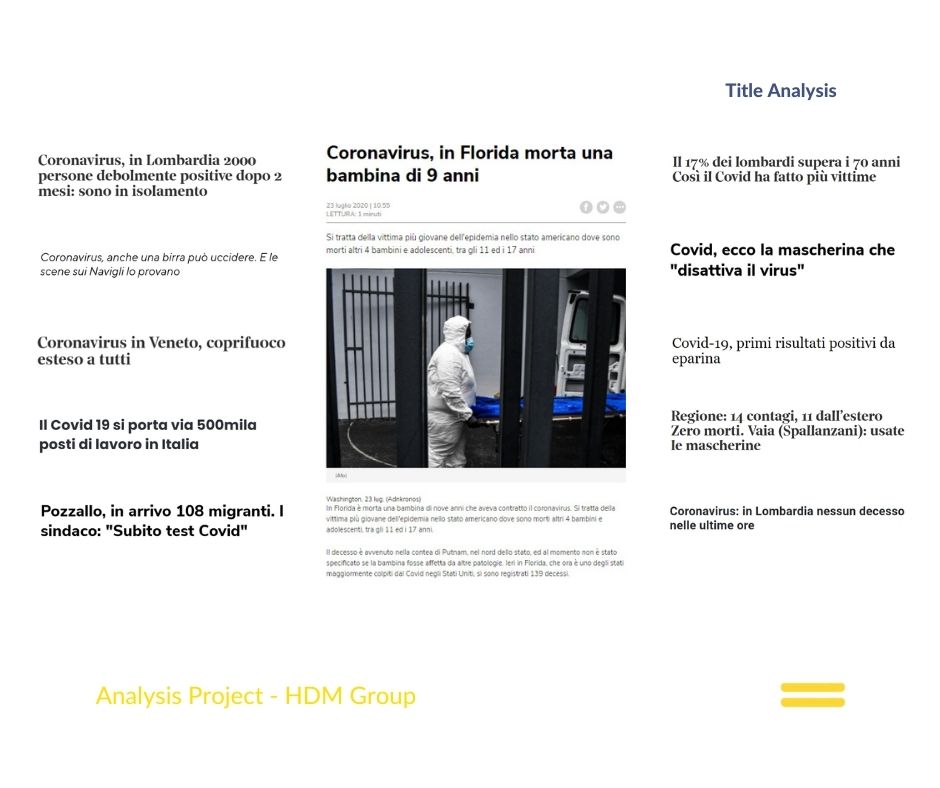
Starting from the sample of 9701 articles published by various italian digital newspapers detected thanks to our software Unity, we collected the most important keywords that involve the pandemic in order to make a research on the titles of the articles and analize their presence.
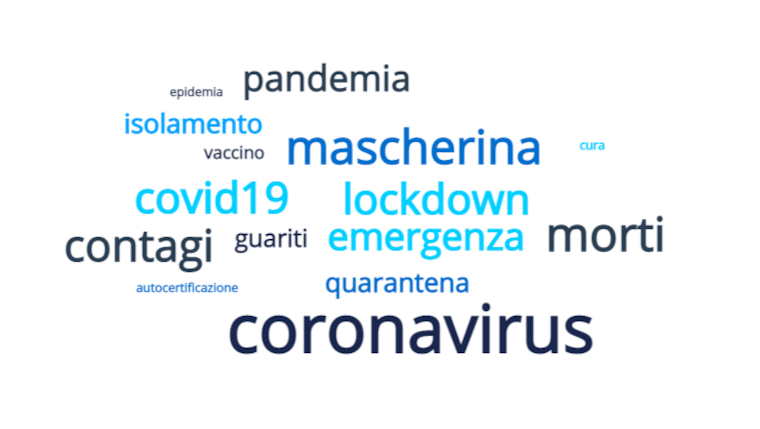
We identified 772 titles that contain at least one of the keywords.
The words that are used more frequently to denominate the virus are: “Coronavirus”, which appears in 273 titles (35% of the title sample); “Covid”, utilized in 217 titles (28%) and “Covid-19”, which appears in 46 titles (6%); no trace of the technical acronym “Sars-Cov-2”.
“Deaths” (Morti) is the third most frequent keyword, involving 64 titles (8%), followed by the keyword “mask” (mascherina) which appears in 64 titles (8%).
The fifth most used keyword in titles is “infections” (contagi) which is part of 48 titles (6%). The keywords “cure” (cura) and “vaccine” (vaccini) appear in very few titles.
On the same sample of 772 titles, we analized their tone.
From this analysis we have found: 161 allarmist titles, 482 neutral titles and 129 positive and reassuring titles.
The majority of allarmist titles involves news about new infections. Positive and reassuring titles describe the absence or the decline of the number of new positive cases of Coronavirus that involved different areas of Italy during the summer of last year.
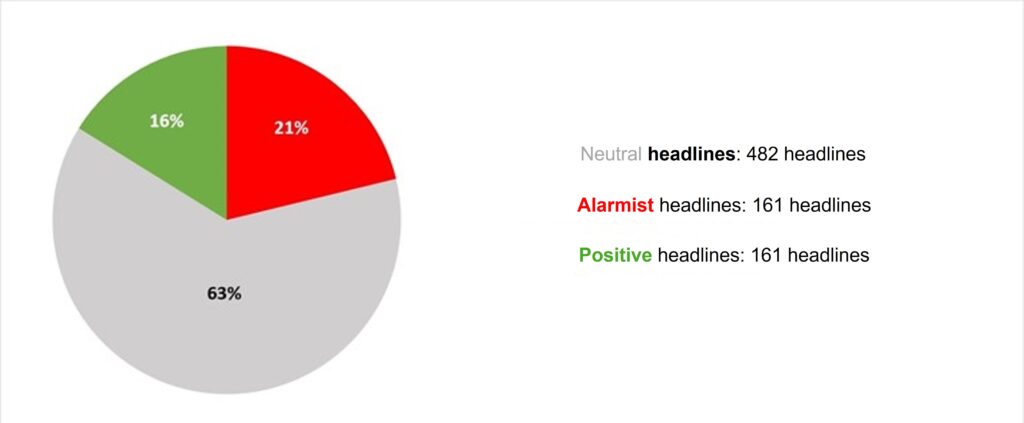
This is our last update on our communication project of analysis concerning the Coronavirus topic, performed thanks to the innovative potential of our data processing and analysis system Unity. Click here for more info.
| Cookie | Duration | Description |
|---|---|---|
| __cfduid | 1 month | The cookie is used by cdn services like CloudFare to identify individual clients behind a shared IP address and apply security settings on a per-client basis. It does not correspond to any user ID in the web application and does not store any personally identifiable information. |
| _GRECAPTCHA | 5 months 27 days | This cookie is set by the Google recaptcha service to identify bots to protect the website against malicious spam attacks. |
| cookielawinfo-checbox-analytics | 11 months | This cookie is set by GDPR Cookie Consent plugin. The cookie is used to store the user consent for the cookies in the category "Analytics". |
| cookielawinfo-checbox-functional | 11 months | The cookie is set by GDPR cookie consent to record the user consent for the cookies in the category "Functional". |
| cookielawinfo-checbox-others | 11 months | This cookie is set by GDPR Cookie Consent plugin. The cookie is used to store the user consent for the cookies in the category "Other. |
| cookielawinfo-checkbox-advertisement | 1 year | The cookie is set by GDPR cookie consent to record the user consent for the cookies in the category "Advertisement". |
| cookielawinfo-checkbox-necessary | 11 months | This cookie is set by GDPR Cookie Consent plugin. The cookies is used to store the user consent for the cookies in the category "Necessary". |
| cookielawinfo-checkbox-performance | 11 months | This cookie is set by GDPR Cookie Consent plugin. The cookie is used to store the user consent for the cookies in the category "Performance". |
| CookieLawInfoConsent | 1 year | Records the default button state of the corresponding category & the status of CCPA. It works only in coordination with the primary cookie. |
| viewed_cookie_policy | 11 months | The cookie is set by the GDPR Cookie Consent plugin and is used to store whether or not user has consented to the use of cookies. It does not store any personal data. |
| Cookie | Duration | Description |
|---|---|---|
| pll_language | 1 year | This cookie is set by Polylang plugin for WordPress powered websites. The cookie stores the language code of the last browsed page. |
| Cookie | Duration | Description |
|---|---|---|
| YSC | session | This cookies is set by Youtube and is used to track the views of embedded videos. |
| Cookie | Duration | Description |
|---|---|---|
| IDE | 1 year 24 days | Used by Google DoubleClick and stores information about how the user uses the website and any other advertisement before visiting the website. This is used to present users with ads that are relevant to them according to the user profile. |
| test_cookie | 15 minutes | This cookie is set by doubleclick.net. The purpose of the cookie is to determine if the user's browser supports cookies. |
| VISITOR_INFO1_LIVE | 5 months 27 days | This cookie is set by Youtube. Used to track the information of the embedded YouTube videos on a website. |
| yt-remote-connected-devices | never | YouTube sets this cookie to store the video preferences of the user using embedded YouTube video. |
| yt-remote-device-id | never | YouTube sets this cookie to store the video preferences of the user using embedded YouTube video. |
| yt.innertube::nextId | never | This cookie, set by YouTube, registers a unique ID to store data on what videos from YouTube the user has seen. |
| yt.innertube::requests | never | This cookie, set by YouTube, registers a unique ID to store data on what videos from YouTube the user has seen. |
| Cookie | Duration | Description |
|---|---|---|
| CONSENT | 16 years 8 months 3 days 15 hours 17 minutes | No description |
| DEVICE_INFO | 5 months 27 days | No description |